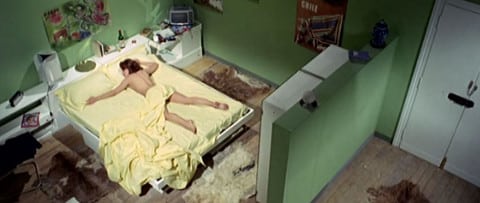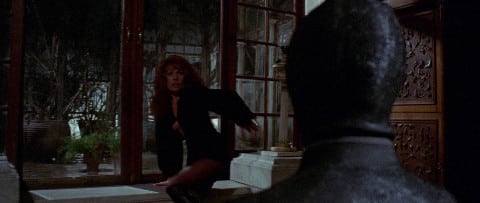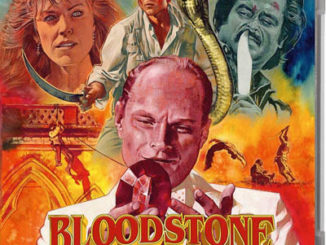The Case of the Scorpion's Tail (1971)
Directed by: Sergio Martino
Written by: Eduardo Manzanos, Ernesto Gastaldi, Sauro Scavolini
Starring: Alberto de Mendoza, Anita Strindberg, Evelyn Stewart, George Hilton
AKA LA COD DELLO SCORPIONE
Italy/ Spain
AVAILABLE ON BLU-RAY from ARROW VIDEO
RUNNING TIME: 92 mins
REVIEWED BY: Dr Lenera, Official HCF Critic
A plane mysteriously explodes in mid air; one passenger is Kurt Baumer, a London businessman who’s insured for $1 million. His unfaithful wife Lisa is the beneficiary. The insurance agency arranges to pay, but is also a little suspicious so assigns their top investigator, Peter Lynch, to sniff out any irregularities. Lisa encounters ex-lover George who threatens her with blackmail, plus Lara Florakis who was Kurt’s mistress and thinks that Lisa committed the murder. Once in Athens for the payout, she decides to take the money in cash and mysteriously plans an immediate trip to Tokyo. Then somebody stabs her to death and takes the money….
The Case Of The Scorpion’s Tail is a particularly fine entry in the giallo sub genre. It may lack the psycho-sexual aspect many giallos contain, but it contains pretty much everything else you would expect and done so well that I genuinely think that the result is possibly an even better introductory movie for giallo virgins than the more better known efforts from Dario Argento and Mario Bava. Don’t get me wrong: those two started the ball rolling and my love and admiration for Bava’s work in particular should be evident from all the reviews for Bava movies that you will find on this website. But they were certainly not the only filmmakers to do strong work with the form, and Sergio Martino must be one of the most notable, even just based on the previous two Arrow releases of his films I reviewed some time ago, The Suspicious Death Of A Minor and the marvelously titled Your Vice Is A Locked Room and I Have The Key. The Case Of The Scorpion’s Tail, though only his second giallo, may be the best of Martino’s efforts that I’ve seen so far. The plot is properly complicated but is well constructed, quite airtight and contains several surprises one of which even seasoned mystery solvers probably won’t guess, the pacing is lively yet allows you time to take in all the twists and turns, the murders are vicious but not lingered upon, there’s some terrific suspense, the filmmaking is stylish, and even the acting is mostly pretty good, the cast in fact virtually comprising a Who’s Who of European cult cinema of the period.
The quality of the film makes it odd that for ages this was probably Martino’s most obscure giallo, it being many years before the English soundtrack was available, which in this movie is the better listening option. As usual, production information is scarce on the Web so it’s straight on to the main part of the review we go, and this film exudes style right from the beginning, as we follow – very closely – a woman in a wide red hat through several rather randomly strung together [if you know London] London locations behind the opening titles while Bruno Nicolai’s jittery main theme plays. The woman enters her house, but the camera instead focuses on the black telephone that you just know is going to either ring or be used to make a call. This person is Lisa, and even when she’s next shown cheating on her husband she appears to be the heroine. After all, in the giallo, heroes and heroines are allowed to be very flawed characters indeed and aren’t always the most sympathetic characters in the film. Unfortunately their lovemaking is inter-cut with shots of a terribly unconvincing [even for the time] model aeroplane with no lights on despite it obviously being intended to be nighttime, and even the explosion, consisting of several shots awkwardly pieced together, is shoddy. Even the best of these films tend to have the odd inept moment, it’s just the way they are.
Lisa becomes the target of a blackmailer who appears to be someone else that she slept with, but when she visits his house to give him some money she finds him crawling along the floor having just been stabbed. It seems that Kurt was hardly the faithful type either, as his mistress Lisa then turns up with her lawyer. They were just about to attempt to change Kurt’s will, though is this guy with her really a lawyer as he seems to prefer menacing people with a knife or an axe? Of course he can’t be the one who then kills Lisa in Greece just when you think she’s going to get friendly with insurance fraud investigator Peter Lynch, around a quarter of the way into the film Psycho-style, that’s just too easy. And why did she want to go to Tokyo? Who’s the mysterious air steward we’re sometimes shown? Lynch isn’t too pleased when he’s joined by Interpol agent John Stanley and Inspector Stavros in his quest, but he’s most certainly pleased that photojournalist Cleo Dupont is also interested in the case. You just know that from the moment that they set eyes on each other they will soon get together, Peter understandably being unable to spurn her advances and seeming to spend as much time swanning around with her in bed and on his boat as trying to find out what’s going on because she’s played by the lovely Anita Strindberg. Actually her and George Hilton do possess some chemistry together and Hilton, formerly a spaghetti western hero who then usually turned up in smaller, sinister parts in giallos, does good in a lead role. He also plays well off Luigi Pistilli as Stavros, who has to stop Peter slapping a witness and even ensures him that the Greek police don’t make a mess when they search rooms.
It’s a while before someone starts to kill off the cast members, though there’s enough to enjoy before and the murder set pieces certainly give Argento’s earlier efforts a run for their money [look out for a pre-Suspiria face being pressed against glass and looking all distorted] despite some rather unconvincing shots of fake torsos and hands. Though done mostly with a dagger, there’s also a quite shocking glass-in-the-eye bit that goes just a bit further than 1971 giallos tended to go, though the bit I will probably remember for far longer [and which Jason Voorhees fans will certainly appreciate] is a tremendous bit of business where a victim-to-be glides in eerie slow motion towards the door which the killer is trying to get through, then turns round and goes upstairs – only for the killer to suddenly crash through a huge window really causing the viewer to jump! Some moments in a theatre set amongst mannequins and horrible one-eyed dolls also work well though of course it would be hard to totally botch them considering how unsettling these things can be anyway. And the climax, a Dead Calm-like confrontation on a boat that then becomes a quite heart-stopping bit of hide and seek on a small Greek island, really is very good indeed, with Martino at the top of his game – it’s hard to believe that this is the same filmmaker who directed the very clumsy The Mountain Of The Cannibal God which I reviewed a few days ago.
The cast also includes the likes of Janine Reynard who was the only good thing in some of Jess Franco’s films, and spaghetti western veteran Alberto de Mendoza as Stanley. He gets the script’s final line and out of the characters who are still alive easily finishes up as the happiest, a good example of the surprisingly good natured feel of the piece despite the amount of blood spilt and corpses turning up. Does the story work? I thought about it a bit and I can’t seem to make out any major plot holes, though some of the behaviour of certain characters is perhaps a little strange in retrospect. Main screenwriter Ernesto Gastaldi, who churned these out a dime a dozen, overall did a very good job here though, as did cinematographer Emilio Foriscot throughout with his frequent employment of both high and very high angles. One major set-piece is tinted green. The way bright splashes of bright red are used throughout is also very effective. They even sometimes turn up on wallpaper. Only one scene is really distracting in the way that it’s done, a bit where two policemen are at a table which is filmed directly from above so the two actors are sideways. Then there’s Nicolai’s score which seems to channel some of Ennio Morricone’s giallo work at times with its strangulated trumpet playing, electronic sounds and the like, though Nicolai’s typically lush melodies are also well in evidence.
There are still some of the usual flaws you find in these films which are evidence of their quick production, such as poorly staged fights and out of sync sound effects. The title, like so many of these giallos that were made to cash in on the success of The Bird With The Crystal Plumage, is only dubiously linked to the film [the killer at one point leaves behind a scorpion brooch]. But in general it really is one of the best of its kind, which perhaps makes it right that in this one a bottle of J & B whisky [with of course the label always facing the camera] shows up on five separate occasions, which could be some kind of record. It first turns up after only a few minutes by a record player in Lisa’s room, then again there, then is seen twice on a table in Peter’s room and on the second time he and Cleo have a glass each. And finally it turns up at an outdoor restaurant, Peter and Cleo having another glass. I can attest to the fact that restaurants in Italy sometimes serve huge amounts of whisky, but aren’t we supposed to be in Greece, and I never went to one where you were left with a whole bottle. Maybe it was different in the 1970’s….
Rating: 









Though I don’t own any earlier version to compare, Arrow’s restoration of The Case Of The Scorpion’s Tail might be the finest of their giallo ones that I’ve seen. Only some instances of overly red flesh tones hold it back slightly, though for all I know it may have been like this in its original release. Everything else looks incredibly natural while still highlighting the vivid colours. Image depth is considerable but so is the level of grain. Now you may recall what I said earlier about the English soundtrack? Well, I meant it. As usual, it’s not that well recorded, and, while most of the cast members seem to be speaking English, it’s often not their own voices that you hear. However, it makes some plot points clearer than in the Italian language version and even adds some character touches, so it really is the one to put on.
So on to the special features which include no less than four new featurettes produced by Arrow. First up though is the audio commentary that was on the French Neo Publishing DVD, Gastaldi interviewed by Federico Caddeo who sometimes feels the need to tell us what’s happening on screen, but mostly it’s Gastaldi’s show, with Caddeo asking all the right questions and Gastaldi answering at length. He says that he was the sole author of this and other screenplays for which others were also credited usually because it was part of the agreement with Spain that a certain number of Spanish names had to be in the credits, gives a good impression of what it was like working on these assembly line movies, and says how Argento’s films are too illogical. He also offers much insight into what it’s like when a script is in the hands of the director. Unfortunately when asked about the origins of the typical giallo outfit he fails to mention Bava’s Blood And Black Lace, and his memory is understandably hazy at times, but otherwise he’s good value and one feels that as a screenwriter his considerable contribution to the giallo has been downplayed.
Under The Sign Of The Scorpion is a new interview with Hilton lasting 21 minutes. The actor says a lot that’s of interest: how his major scene was cut, how a tsunami threatened cast and crew when filming the climax, and Strindberg’s failed breast implants.The Scorpion’s Tale is 47 minutes [far exceeding one in some of the older releases]with Martino, and he never once bores with his lengthy answers. He tells a somewhat different version of the tsunami story, says how his efforts to make the film speedy resulted in it being too short so he shot extra footage in London, and, while considering the film to be one of his best, wishes there were less zooms. Jet Set Giallo has Mikel J. Koven talk about The Case Of The Scorpion’s Tail’s place in the genre for 20 minutes and how the latter went through particular phases where certain elements were repackaged. And finally Troy Howarth in the 15 minute The Case Of The Screenwriting Auteur makes a great case for Gastaldi to be considered as much a giallo auteur as some of the well known directors he worked for. Hear Hear!
A really good giallo in a release which Arrow have clearly worked on as hard as they can to make it as definitive as possible. Fans of this type of movie should need no further incentive to buy it, while if you’re a newcomer to this crazy sub genre then is a great place to start. You won’t look back. Highly Recommended!
SPECIAL EDITION CONTENTS
*Brand new 2K restoration of the film from the original camera negative
*High Definition Blu-ray (1080p) presentation
*Original lossless mono Italian and English soundtracks
*Newly translated English subtitles for the Italian soundtrack
*Optional English subtitles for the deaf and hard of hearing for the English soundtrack
*Audio commentary with writer Ernesto Gastaldi, moderated by filmmaker Federico Caddeo (in Italian with English subtitles)
*Under The Sign Of The Scorpion: New interview with star George Hilton
*The Scorpion’s Tale: New interview with director Sergio Martino
*Jet Set Giallo: New analysis Sergio Martino’s films by Mikel J. Koven, author of La Dolce Morte: Vernacular Cinema and the Italian Giallo Film
*New video essay by Troy Howarth, author of So Deadly, So Perverse: 50 Years of Italian Giallo Films
*Theatrical trailer
*Reversible sleeve featuring original and newly commissioned artwork by Chris Malbon
FIRST PRESSING ONLY: Illustrated collector’s booklet featuring new writing on the film by Rachael Nisbet and Howard Hughes, and a biography of star Anita Strindberg by Peter Jilmstad








Be the first to comment